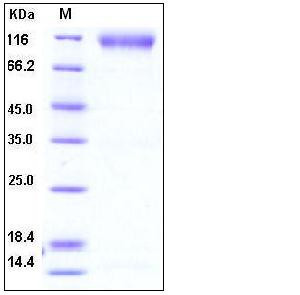Human FGFR2 Protein (His & Fc Tag)
BBDS,BEK,BFR-1,CD332,CEK3,CFD1,ECT1,JWS,K-SAM,KGFR,TK14,TK25
- 100ug (NPP3861) Please inquiry
| Catalog Number | P10824-H03H |
|---|---|
| Organism Species | Human |
| Host | Human Cells |
| Synonyms | BBDS,BEK,BFR-1,CD332,CEK3,CFD1,ECT1,JWS,K-SAM,KGFR,TK14,TK25 |
| Molecular Weight | The recombinant human FGFR2/Fc is a disulfide-linked homodimer after removal of the signal peptide. The reduced monomer consists of 604 amino acids and has a predicted molecular mass of 67.6 kDa. In SDS-PAGE under reducing conditions, the apparent molecular mass of rhFGFR2/Fc monomer is approximately 110-120 kDa due to glycosylation. |
| predicted N | Arg 22 |
| SDS-PAGE |  |
| Purity | > 90 % as determined by SDS-PAGE |
| Protein Construction | A DNA sequence encoding the human FGFR2 (NP_000132.3) extracellular domain (Met 1-Glu 377) was fused with the C-terminal polyhistidine-tagged Fc region of human IgG1 at the C-terminus. |
| Bio-activity | Measured by its ability to inhibit FGF-acidic (aFGF/FGF1) dependent proliferation of Balb/C 3T3 mouse fibroblasts. The ED50 for this effect is typically 0.5-2.5 ng/ml. |
| Research Area | Signaling |Signal Transduction |Protein Kinase |Receptor Tyrosine Kinase (RTK) |
| Formulation | Lyophilized from sterile PBS, pH 7.4 1. Normally 5 % - 8 % trehalose, mannitol and 0.01% Tween80 are added as protectants before lyophilization. Specific concentrations are included in the hardcopy of COA. |
| Background | FGFR2, also known as CD332, belongs to the fibroblast growth factor receptor subfamily where amino acid sequence is highly conserved between members and throughout evolution. FGFR2 acts as cell-surface receptor for fibroblast growth factors and plays an essential role in the regulation of cell proliferation, differentiation, migration and apoptosis, and in the regulation of embryonic development. It is required for normal embryonic patterning, trophoblast function, limb bud development, lung morphogenesis, osteogenesis and skin development. FGFR2 plays an essential role in the regulation of osteoblast differentiation, proliferation and apoptosis, and is required for normal skeleton development. It also promotes cell proliferation in keratinocytes and imature osteoblasts, but promotes apoptosis in differentiated osteoblasts. FGFR2 signaling is down-regulated by ubiquitination, internalization and degradation. Mutations that lead to constitutive kinase activation or impair normal CD332 maturation, internalization and degradation lead to aberrant signaling. Over-expressed FGFR2 promotes activation of STAT1. Defects in CD3322 are the cause of Crouzon syndrome, Jackson-Weiss syndrome, Apert syndrome, Pfeiffer syndrome, Beare-Stevenson cutis gyrata syndrome, familial scaphocephaly syndrome, lacrimo-auriculo-dento-digital syndrome and Antley-Bixler syndrome without genital anomalies or disordered steroidogenesis. |
| Reference |
